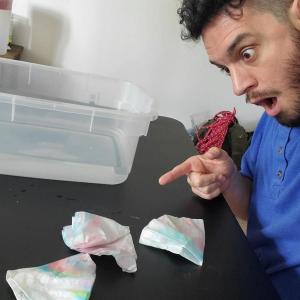
Make Your Own Red Cabbage pH Indicator

Red Cabbage Indicator:
- Red cabbage
- Knife
- Blender
- Strainer
- Distilled water or tap water.
Materials for Experiment:
- Red cabbage pH indicator
- Three or more small beakers (200 mL) or clear plastic cups.
- Measuring spoons
- Baking soda
- Vinegar
- Extension: Other substances for testing such as lemon juice, milk and ammonia.
Make your own red cabbage pH indicator

Chemicals and pH paper are typically used in a laboratory setting for indicating pH. Red cabbage pH indicator is an easy and safe substitute that can be made in a classroom or at home.
Start by cutting the cabbage into strips. Add the cabbage and one cup (or 200 mL) of water into the blender. Blend the water and cabbage and then strain the mixture, saving the liquid.
Adjust the amount of water accordingly. You will need roughly 5 mL of indicator per test.
Using your red cabbage pH indicator
Setup:
- Cup One: mix 150 mL of water and a tablespoon (about 15 mL) of baking soda.
- Cup Two: mix 150 mL of water and two tablespoons (about 30 mL) of vinegar.
- Cup Three: 150 mL of water.

Add a half teaspoon (or 2.5 mL) of red cabbage pH indicator to each cup and observe.
Results:
The cup with baking soda will turn blue, the water cup will turn violet and the vinegar cup will turn red. There may be slight color variations based on the type of water used in the pH indicator and the water used in the cups.

The chart below pairs the pH range with colors you will observe using a red cabbage indicator.
|
Approximate pH Range |
1 to 5 |
6 to 7 |
8 to 9 |
10 to 11 |
12 to 14 |
|
Color |
Red/pink |
Violet |
Blue |
Blue/green |
Green |
Background Information:
pH is a measure of hydrogen ion concentration of a solution. The pH range is measured from 1 to 14. A pH of 7 shows a neutral substance where there are equal hydrogen and hydroxide ions. A pH lower than 7 shows an acid with a higher hydrogen ion concentration, and a pH higher than 7 shows a base with lower hydrogen ion concentration.




